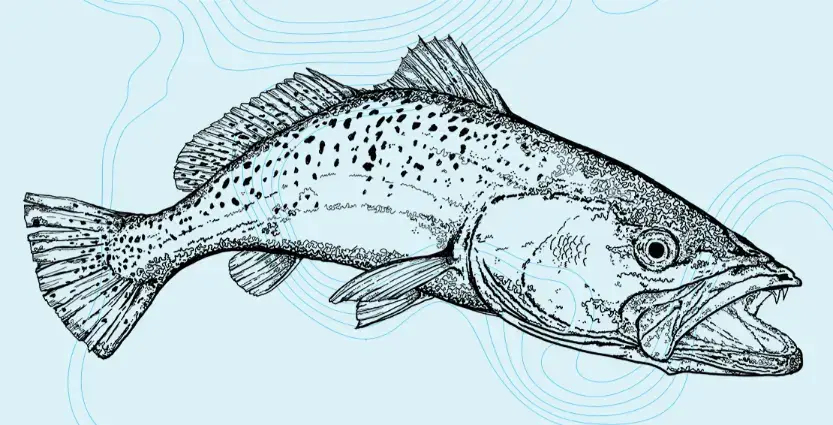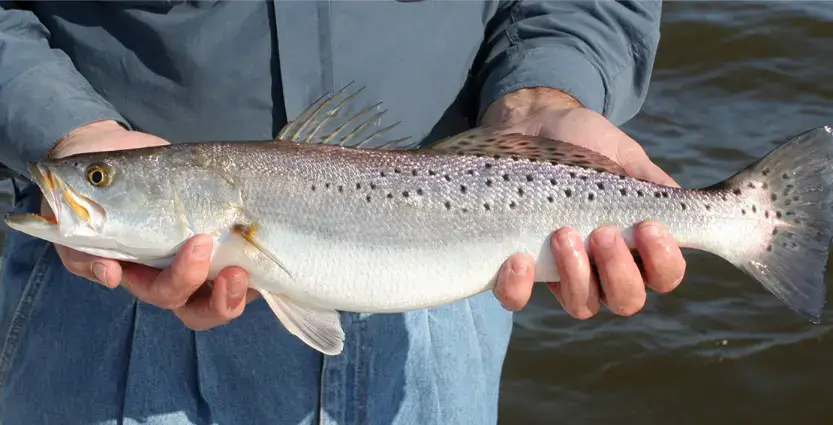Speckled Trout Stock Statusin North Carolina



Stock Overview
Speckled Trout, also known as Spotted Seatrout, are a prized inshore species in North Carolina, known for their striking appearance and importance to both recreational and commercial fisheries. For Speckled Trout, the FINDEX gap assessment compared Target and Terminal values of Fishing Mortality (F30%) and Spawning Stock Biomass (SSB30%) from the stock assessment developed by the NC Division of Marine Fisheries. The stock assessment model uses 2019 as the Terminal year (the most recent data year). However, scientists averaged data from 2017-2019 to calculate the 2019 Fishing Mortality value. To maintain consistency, we applied the same approach for all data reported here.
How It’s Calculated
FINDEX is a novel way to gauge whether the status of a fish population is trending up or down. Management of most fish species in North Carolina is guided by stock assessment models developed by various groups of scientists. The calculations in our FINDEX metric measure the gap between the desired condition of a fish stock (the Target reference value) and the existing condition (the most recent data year in the model called the Terminal value) as determined in each stock assessment. The gaps between Target and Terminal values are reported as ratios.

(0.506 x 1.32) x 100 = 66.8%
FINDEX = 66.8% for 2019

What Does Deficient Mean?
“Deficient” is assigned to any stock with a FINDEX value between 50 and 99%.The most recent peer-reviewed stock assessment model for Speckled Trout (2019 data) tells a mixed story. Spawning Stock biomass (the estimated metric tons of females in the population) performed well relative to the Target reference value, indicating the population was not “overfished”.
On the other hand, the Fishing Mortality estimate was too high relative to the Target reference value suggesting “overfishing” was occurring. Stock status suggesting “overfishing” is occurring, while at the same time indicating that the stock is not “overfished” is confusing and difficult to interpret. Our FINDEX metric remedies this confusion by classifying Speckled Trout status as “Deficient”.
Status Over Time
The stock assessment model for Speckled Trout provides point estimates of Fishing Mortality and Spawning Stock Biomass for each year covered in the data set. We’ve compared the Target reference values to these annual point estimates and calculated the ratios (gaps) for each data year from 1991 to 2019. Applying the FINDEX gap assessment to the entire time series provides the following stock status trendline.
How Do We Get To World-Class?
Speckled Trout Target values for Fishing Mortality (0.38) and Spawning Stock Biomass (1,714 metric tons) have been established by the management agencies. The existing estimates (2019 values) are 0.75 and 2,250 metric tons. Under one potential scenario, if Fishing Mortality was to drop to the Target, and Spawning Stock Biomass was to increase to 3,450 metric tons, then the FINDEX value would exceed 200% on our barometer. The vision of the NC Marine & Estuary Foundation is to see our coastal stocks exceed Target expectations as we pursue World-Class fisheries and thriving coastal economies.
Commercial Trends
The graph below illustrates commercial trends for Speckled Trout from 1990 through 2022. In 2022, commercial fishers harvested 603,155 pounds of Speckled Trout valued at $1,712,579. Supporting data was sourced from the North Carolina Department of Environmental Quality.
Recreational Trends
The graph below illustrates recreational trends for Speckled Trout from 1990 through 2022. In 2022, recreational fishers harvested an estimated 1,963,400 Speckled Trout weighing 3,756,040 pounds. Supporting data was collected through the Marine Recreational Information Program as sourced from the North Carolina Department of Environmental Quality.
Speckled Trout
Did You Know?
- Speckled Trout are subjected to “cold stun” events when water temperatures drop below 40oF, and fish kills are often observed when temperatures remain below 37oF. Natural mortality is a serious concern for Speckled Trout stocks and can help explain the occasional dips in commercial and recreational harvest trends as seasons have been closed periodically (2011, 2014, and 2018) due to winter fish kills.
- Ten-year-old Speckled Trout have been observed in Virginia and Florida, with fish as old as 9 years collected in North Carolina.
- Speckled Trout are considered a type of drum, and are in the same family as Red Drum, Black Drum, Spot, and Croaker.
State Record
- North Carolina’s state record Speckled Trout was caught from the Neuse River in 2022 by Todd Spangler.
- The record-breaking fish weighed 12 pounds, 8 ounces.
Harvest Seasons
for Speckled Trout
- The recreational limit for Speckled Trout is currently 4 fish per day, with a minimum size limit of 14 inches in total length.
- Commercial fishing operations for Speckled Trout are limited to 75 fish per day, and a 14-inch minimum size limit is also in effect. No annual quotas currently exist. Proclamations for Speckled Trout can be found here.
Stay Current
As our team diligently refines FINDEX, we’re committed to delivering the most recent stock status updates for North Carolina’s diverse finfish species. Subscribe below to receive a stream of inshore insights and stay current with our coastal initiatives.
